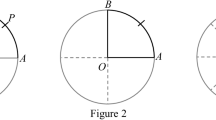Abstract
A challenging task when doing research in mathematics education is the comprehensible description of activities shown by students and their construction of new knowledge as well when doing mathematics. Charles S. Peirce's semiotics seems to be a well promising tool for fulfilling this task. Since several years, Peirce's semiotics is well known and extensively discussed in the scientific community of mathematics education. Among the numerous research reports several papers dealing with Peirce's semiotics concentrate on the meaning of diagrams as a tool for gaiming new knowledge. The aim of the following paper, where a case study will be presented, is to offer the usefulness of such a view on diagrams. In this study two students, which have to solve a problem from elementary geometry, are introduced. The question presented to them asked for a mathematical description of the movement of a rigid body. To answer this question they started experimenting with this rigid body and afterwards invented and used diagrams in manifold ways. Video-based data show these diagrams to be the source of new mathematical knowledge for these students. Therefore, this paper offers Ch. S. Peirce's semiotics as a successful theoretic frame for describing and interpreting the learning activities of students and their use of diagrams to solve a given mathematical task.
Similar content being viewed by others
References
Anderson, M., Sáenz-Ludlow, A., Zellweger, S., & Cifarelli, V. V. (Eds.) (2003):Educational perspectives on mathematics as semiosis: from thinking to interpreting to knowing. New York, Ottawa, Toronto: Legas.
Arzarello, F., Olivero, F., Domingo, D., & Robutti, O. (2002). A cognitive analysis of dragging practices in Cabri environments.Zentralblatt für Didaktik der Mathematik, 34(3), 66–72.
Bakker, A., & Hoffmann, M. H. G. (2005). Diagrammatic Reasoning as the Basis for Developing Concepts: A Semiotic Analysis of Students' Learning about Statistical Distribution.Educational Studies in Mathematics, 60(3), 333–358.
Boehm, G. (1994). Die Wiederkehr der Bilder. In G. Boehm (Ed.),Was ist ein Bild? (pp. 11–38). München: Wilhelm Fink Verlag.
Cobb, P., Yackel, E., & McClain, K. (Eds.), (2000).Symbolizing and communication in mathematics classrooms: perspectives on discourse, tools, and instructional design. Mahwah, NJ: Lawrence Erlbaum.
Dörfler, W. (2005). Diagrammatic Thinking. Affordances and Constraints. In M. Hoffmann, J. Lenhard & F. Seeger (Eds.),Activity and sign: grounding mathematics education (pp. 57–66). New York: Springer.
Dörfler, W., & Kadunz, G. (2006). Rezension von “Erkenntnisentwicklung”.Journal für Didaktik der Mathematik (JMD), in press.
Goldin, G. A., & Kaput, J. J. (1996). A Joint Perspective on the Idea of Representation in Learning and Doing Mathematics. In L. P. Steffe & P. Nesher (Eds.),Theories of Mathematical Learning. Mahwah NJ: Lawrence Erlbaum.
Goldin, G. (1998). Representational Systems, Learning and Problem Solving in Mathematics.Journal of Mathematical Behavior, 17(2), 137–165.
Goldin, G. (1998a). The PME Working Group on Representations.Journal of Mathematical Behavior, 17(2), 283–299.
Goodman, N. (1976).Languages of Art. An Approach to a Theory of Symbols. Indianapolis: Hackett Publishing Company.
Hoffmann M. H. G. (Ed.) (2003).Mathematik verstehen. Semiotische Perspektiven. Hildesheim, Berlin: Franzbecker.
Hoffmann, M. H. G. (2005). Signs as Means for Discoveries. Peirce and His Concepts of “Diagrammatic Reasoning”, “Theorematic Deduction”, “Hypostatic Abstraction”, and “Theoric Transformation”. In M. Hoffmann, J. Lenhard & F. Seeger (Eds.),Activity and sign: grounding mathematics education (pp. 45–56). New York: Springer.
Hoffmann, M. H. G. (2005a).Erkenntnis-entwicklung. Frankfurt am Main: Vittorio Klostermann.
Hoffmann, M. H. G. (2006). What is a “Semiotic Perspective”, and what could it be? Some comments on the contributions to this special issue.Educational Studies in Mathematics, 61, 279–291.
Kadunz, G. (2003). Geometrielernen mit computergenerierten Repräsentationen. In M. Hoffmann (Ed.),Mathematik verstehen. Semiotische Perspektiven (pp. 95–118). Hildesheim, Berlin: Franzbecker.
Kadunz, G., & Straesser, R. (2004). Image-Metaphor-Diagram: Visualisation in Learning Mathematics. In ProceedingsPME 28 (Vol. 4, pp. 241–248). Bergen: Bergen University College.
Latour, B. (1987).Science in Action: How to Follow Scientists and Engineers through Society. Cambridge, MA: Harvard University Press.
Mitchell, W. J. T. (1994).Picture Theory. Chicago. The University of Chicago Press.
Nöth, W. (1995).Handbook of Semiotics. Bloomington: Indiana University Press.
Oliveri, G. (1997). Mathematics, a science of patterns?Synthese, 112, 379–402.
Peirce, C. S. (1976).The New Elements of Mathematics (NEM) (Vol. I–IV). The Hague-Paris/Atlantic NJ: Mouton/Humanities.
Peirce, C. S. (1998).The Essential Peirce=EP xxxx (volume:page number). Bloomington and Indianapolis: Indiana University Press.
Presmeg, N. (2006). Semiotics and the “connections” standard: significance of semiotics for teacher of mathematics.Educational Studies in Mathematics, 61, 163–182.
Sáenz-Ludlow, A. (2006). Classroom interpreting games with an illustration.Educational Studies in Mathematics, 61, 183–218.
Sáenz-Ludlow, A., & Presmeg, N. (2006a). Guest editorial semiotic perspectives on learning mathematics and communicating mathematically.Educational Studies in Mathematics, 61, 1–10.
Seeger, F. (2000).Lernen mit grafischen Repräsentationen: Psychologische und semiotische Überlegungen. Semiotik, 22(1), 51–79.
Stjernfelt, F. (2000).Diagrams as Centerpiece of a Peircian Epistemoloy. Transactions of Charles S. Peirce Society, XXXVI(3), 357–384.




